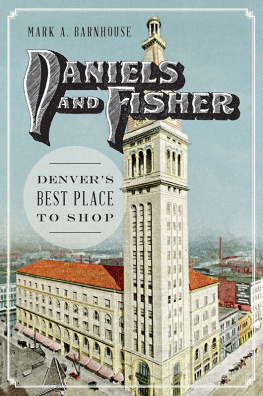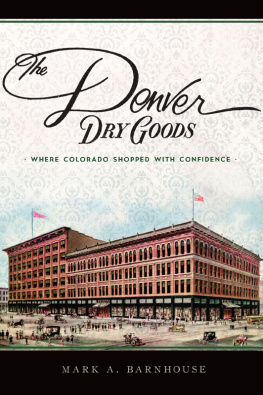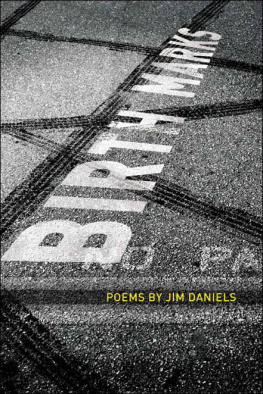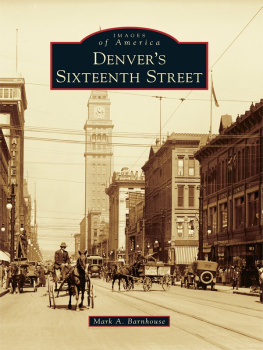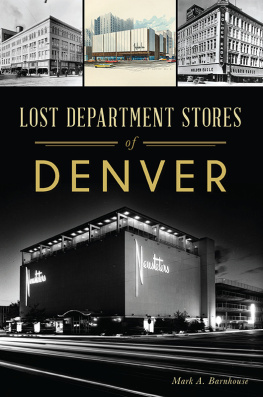

Published by The History Press
Charleston, SC
www.historypress.net
Copyright 2015 by Mark A. Barnhouse
All rights reserved
Front cover: Authors collection.
First published 2015
e-book edition 2015
ISBN 978.1.62585.460.5
Library of Congress Control Number: 2015949883
print edition ISBN 978.1.62619.923.1
Notice: The information in this book is true and complete to the best of our knowledge. It is offered without guarantee on the part of the author or The History Press. The author and The History Press disclaim all liability in connection with the use of this book.
All rights reserved. No part of this book may be reproduced or transmitted in any form whatsoever without prior written permission from the publisher except in the case of brief quotations embodied in critical articles and reviews.
For my sister, Sandra Ellen Barnhouse, a long-ago May-D&F employee.
CONTENTS
ACKNOWLEDGEMENTS
Many kind people contributed in both tangible and intangible ways to this book. I am particularly indebted to former May-D&F vice-president Robert Bob Rhodes, who graciously shared both memories and photographs; Alan Golin Gass, FAIA, who shared photographs and wonderful stories of his time working with I.M. Pei; Richard Hentzell, the driving force behind the Daniels and Fisher Towers continuing vitality in recent years, who enlightened me regarding some obscure points; and Ron and Judy Proctor, whose extensive collection of Daniels and Fisher memorabilia and knowledge of the stores past made this a more interesting book. I am grateful to the following individuals who shared memories or photos or helped in other ways: Robert and Kristen Autobee, Sandra E. Barnhouse, Regina Bullock, Serena Elavia and the Atlantic, Carol Hiller, Becky LeJeune, Dr. Thomas J. Noel, Heather Ormsby, Richard Rhodes, Suzanne Ryan, Jodi Sokup of Clocktower Events, Shantelle Stephens and Izzy Vera. The always-helpful people at the Denver Public Library Western History and Genealogy Collection were invaluable (in particular, Abby Hoverstock and Coi Drummond-Gehrig), as was the fine staff at the Stephen H. Hart Library at History Colorado (in particular, Melissa VanOtterloo). Thanks, too, to Jaime Bourassa of the Missouri History Museum, Library and Research Center. At The History Press, editor Krista Slavicek was both helpful and patient. As always, thank you for everything you do, Matt.
Introduction
TWO LANDMARK STORES
This book tells the story of two Denver department stores that together served residents of the Mile High City and all Coloradoans for thirteen decades. Daniels and Fisher was born in 1864, when Denver was only six years old; its successor store, May-D&F, began operations in 1958, after May Company (founded in Leadville, Colorado, in 1877) bought Daniels and Fisher and merged the older stores operations with its own. It continued operating as May-D&F until a corporate reshuffling in 1993 resulted in its name vanishing from the Denver landscape.
These two stores, one succeeding the other, are united by not only the lineage of their names but also by the architectural approach they took to their buildings: both Daniels and Fisher and May-D&F built landmarks on Denvers Sixteenth Street that made shopping a special event. Their competitors (Denver Dry Goods, Joslins and, in earlier years, Golden Eagle) were all successful and respectable merchants, but their buildings were relatively utilitarian, designed to house goods but not make a mark on the cityscape.
Roughly resembling Venices Campanile di San Marco, the slender Daniels and Fisher Tower occupies a plot of ground only 40 feet square and rises 330 feet (375 feet with flagpole) from the corner of the Sixteenth Street Mall and Arapahoe Street. To a person unacquainted with the towers history, it would seem an architectural follynot connected to any larger building, its small footprint makes it appear as though it couldnt have been built for any useful purpose. The design is classical: a stone base, a buff-colored brick shaft and a pyramidal crown capped by a cupola. Near the top, clock faces point in four directions; just below the clock, columns and arches handsomely frame inset balconies. Over the door, a plaque proclaims Erected by William Cooke Daniels MCMXI. The tallest building between Chicago and San Francisco when built, it reigned over Denvers skyline for more than four decades after its 1911 debut. No mere folly, the tower not only served as a symbol of the fine department store to which it was once attached but also marked Denvers maturation from frontier outpost into a big city.
Several blocks up the Sixteenth Street Mall, at the corner with Tremont Street, another landmark once stood that, in a later era, also signaled Denvers transformation from provincial burg into worldly city. May-D&F opened in 1958 as the first completely new major department store in the country to be built in the heart of a downtown area since World War II. For his May-D&F-anchored Courthouse Square project, he commissioned his architect, I.M. Pei, to create something special, and Pei did: a 400,000-square-foot department store, clad in golden aluminum, with a thin-shell concrete, glass-walled hyperbolic paraboloid in front serving as its glorious entrance. Adjoining the paraboloid, Pei designed a sunken plaza, used in winter as a Rockefeller Centerstyle urban ice-skating rink. Across Court Place, a vast hotel complemented the store, paraboloid and plaza, the assemblage creating just the worthwhile contribution to Denver that Zeckendorf had promised. When May-D&F opened, it adopted the moniker Shopping Wonder of the West, and for a time, it was.
There is more to the story than landmark buildings or the commerce that took place inside them. By their very nature, department stores are about people. William Bradley Danielsconservative, proper Episcopalian that he wasproved perfectly capable of letting his heart rule his head when he met the alluring Donna Madixxa. His son, William Cooke Daniels, raised in luxury and given every advantage, was not content to live as a pampered millionaire but gave of himself, furthering the cause of science, volunteering to serve his country and building his city a token of his esteem that is still with us today. A third William, Zeckendorf, sought to wake up sleepy Denver, wrest it into the twentieth century and perhaps make a dollar at the same time. William Garrett Fisher, David May, Charles MacAllister Willcox, Cicely Banner Daniels, Florence Martin, Joe Ross, Carl Sandell, Mary Alice Fitzgerald, Bob Rhodessome well-known names, and some not so well-known, but each of them contributes their human stories to this narrative.

Daniels and Fisher after the 1911 completion of its landmark tower. Thomas J. Noel Collection/Library of Congress.

May-D&F, centerpiece of Courthouse Square, circa 1960. Denver Public Library, Western History Collection.
Daniels and Fisher was Denvers pioneer store, a homegrown institution that never lost sight of its western roots even as it aspired to put Denver on the map with its splendid tower. May-D&F succeeded Daniels and Fisher, and although controlled by a parent company one thousand miles away, for many years it embodied a Colorado personalityMay Companys roots were in the state, too, after all. These were Colorado stores for Colorado people, and Colorado took pride in them.
Next page
